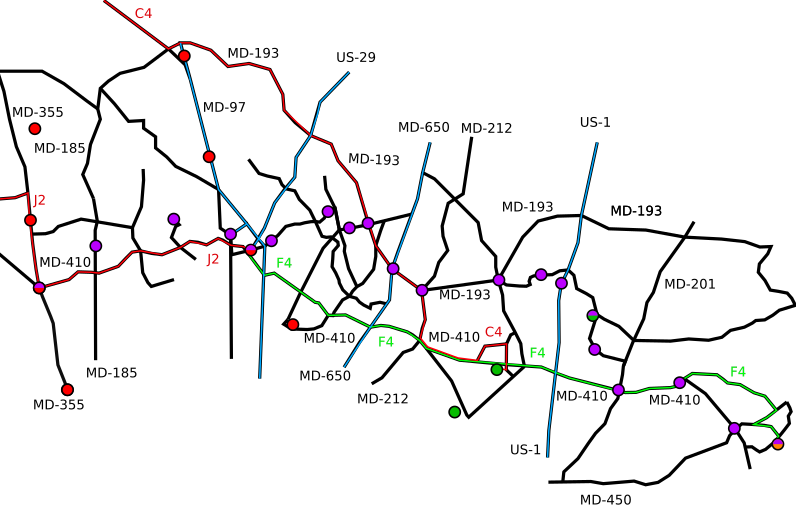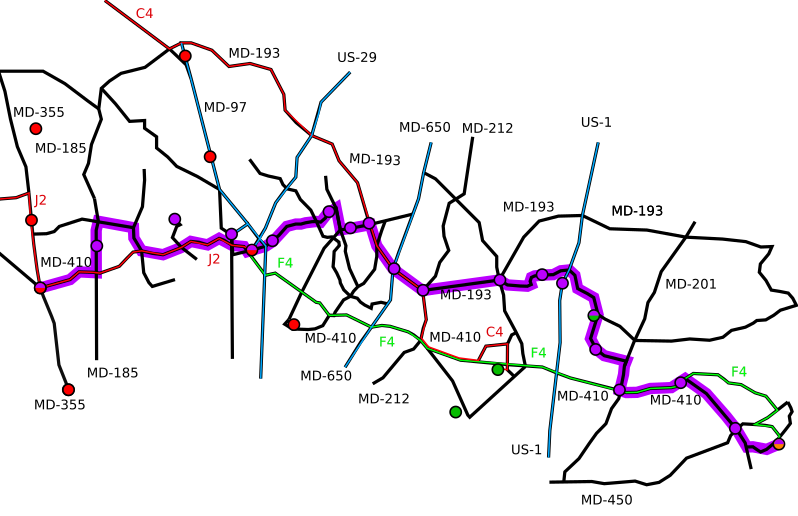GGWash Sandbox: Could an interim bus mirror the Purple Line route?
_800_535_90.jpg)
A Metro bus that we've colored purple. Image used with permission.
Welcome to our very first “GGWash Sandbox” post, a series where we explore contributor-imagined visionary ideas to make the Washington region greater. These are unofficial ideas that decision-makers have neither studied nor endorsed, so these proposals may or may not actually be feasible for a variety of reasons. As such, we have an expert or two weigh in on what the likely sticking points might be. We hope these ideas spark discussion.
Maryland spent years studying whether a bus would work for the Purple Line permanently, and correctly determined that it wouldn't and that light rail is needed. Now, after more than a decade of political uncertainty and legal challenges, construction on the light rail line connecting New Carrollton, College Park, Silver Spring, and Bethesda finally began in late 2017 and is scheduled to be completed in late 2022.
While the rail line is under construction, could an interim bus provide partial benefit sooner?
The Purple Line’s route will allow for much faster travel through the area it serves. Some of this will come from having its own lanes and being grade-separated over several intersections, so it doesn't have to stop like buses and cars. The route is also more direct and has a limited number of stops.
Metrobus stops are generally much closer together. This reduces the distance that riders need to walk to the bus, but for longer trips this advantage is often outweighed by the time cost of frequent stops, especially when the bus must wait for riders to pay as they board. The Purple Line’s off-board payment and greater stop spacings will significantly shorten the trip.
There is no current bus service — or even pair of bus services — that serves all of the stops on the Purple Line. Instead, a patchwork of bus routes requiring at least one transfer is all that serves the Purple Line route now.
A map of the Purple Line corridor, showing current major bus service. Current bus service in the Purple Line area by the author.
Although the area served by the Purple Line includes dense, walkable urban downtowns in Bethesda and Silver Spring, few bus lines provide frequent service between the increasingly dense and transit-dependent communities along the “International Corridor” in Langley Park, the University of Maryland, and the transit-oriented development being built at the New Carrollton Metro. Buses come every 20 minutes only on a few major routes.
Bus service could encourage transit-oriented development and serve more riders along the corridor sooner than the four to five years we will have to wait for the Purple Line. It would ensure that new construction along the corridor wouldn't have to wait to be served by the frequent, rapid connections promised by the Purple Line.
How a Purple Line bus could work
Without building any new infrastructure, local transit agencies could provide express bus service along an approximation of the Purple Line route, serving only Purple Line stations and providing a frequency comparable to what the Purple Line will provide.
The fact that parts of the Purple Line will follow off-road rights-of-way does require that a slightly different path be used for the bus. Below, I’ve proposed an alternate routing that serves nearly all the stations of the actual Purple Line, which will require some service to temporary stations located in slightly different locations.
A map of the Purple Line corridor, showing a possible route for frequent, all-day, seven-day-a-week bus service. Proposed bus service for the Purple Line area by the author.
Here's where the “Purple Line Bus” would go
Starting from the New Carrollton Metro Station, this bus would serve the exact Purple Line route until it reached the College Park Metro Station. From there, it would follow Campus Drive across US-1, requiring a stop two blocks north of the Rossborough Drive station planned for the Purple Line. It would then follow the planned Purple Line route through the University of Maryland campus and along University Boulevard to Piney Branch Road.
The bus would then need to go along Flower Avenue to Wayne Avenue, slightly diverging from the tunnel route planned for the Purple Line, but it could then follow the Purple Line route along Wayne Avenue to the Silver Spring Transit Center. West of Silver Spring, the Purple Line follows the Metropolitan Branch / Red Line and Georgetown Branch railroad rights-of-way, so a bus route following major roads will have to be somewhat different.
The 16th Street station along the Metropolitan Branch could be served by a stop at 16th Street and East-West Highway, two blocks to the south. Next, the Lyttonsville station would be impossible to serve well without significant back-tracking along relatively narrow roads without a regular street grid, so it might be easiest to serve it with a station at East-West Highway and Lyttonsville Place.
The bus could continue west along East West Highway past Lyttonsville Place, but a detour to the north along Jones Mill Road, Jones Bridge Road, and Manor Road to Connecticut Avenue would allow it to reach the Connecticut Avenue station before continuing south along Connecticut Avenue to follow East-West Highway the rest of the way to the Bethesda Metro Station.
Breaking down the costs
A car trip along this route takes about 65 minutes at midday according to Google Maps. Add one minute for each of the route’s 18 stops equals 83 minutes. That's 20 minutes slower than the Purple Line, but significantly faster than with current bus service.
While running times would likely be much higher at rush hour, for most of the day a bus could complete this route in 90 minutes. If we assume one bus every 10 minutes in each direction, then 12 buses would be needed for the route, or 15 with some reserved for more congested times of the day. If the line runs 18 hours a day, this is 270 bus-hours a day, 365 days a year, which comes out to 98,550 revenue hours a year.
The Federal Transportation Administration’s National Transit Database says Metrobus’s operating costs are roughly $160 per revenue hour, while the Maryland MTA’s are $158 per revenue hour and Montgomery County's Ride-On’s are $112 per revenue hour.[1]
Using the average of these three costs ($143.33) gives an operating cost of $14 million per year to provide Purple Line bus service. The actual cost is likely to be somewhat lower, since frequent, all-day routes have less “deadheading” to the start of routes and some costs, like maintenance facilities and workers, scale with calendar time rather than vehicle operating time.
If we assume a farebox recovery ratio of 23.5%, matching WMATA's bus farebox recovery ratio of 24% and Ride On's of 23%, the actual cost of operating the service would be roughly $11 million annually.
An annual cost of $11 million is roughly 10% of the total cost after fare revenue of operating Prince George's County's TheBus network, or 7% of the cost after fare revenue of operating Montgomery County's Ride On network: not an insurmountable challenge if there is political will to support it. This cost could be lowered further by operating at lower frequencies during low demand periods, such as weekends and evenings. However, this would reduce the benefit to the public.
Is this feasible?
James Hamre, director of WMATA's Office of Metrobus Planning and Scheduling, notes that this isn't a brand new idea:
We did this study in 2007 and it has informed the process of service adjustments on J4 and C4 since. There is no bus route to replicate the Purple Line as there isn’t a single roadway that makes this trip. The core of Purple Line ridership is a collection of overlapping shorter trips. Nearly no one is expected to ride from end to end.
And he says the proposal might actually cost less than my estimates because the existing infrastructure is already in place:
Both Montgomery County and WMATA represent a lower cost per hour to operate than estimated. I seem to recall the County is around $85 and we are $95. This is the incremental cost of operation. The fact is that our organizations already exist, so the costs of administration, personnel, payroll, insurance, garages, buses, etc. already exist. New service requires operators, supervisors and added miles and hours of fuel, tires, and maintenance.
But getting the funding to cover the cost is likely a sticking point:
It should also be noted that the State of Maryland would be the agency to provide the funding, as they provide all subsidy for Metrobus. Neither of the locals provide a payment, which is why initiatives have dried up in Maryland these days.
Prince George's contributor Bryan Barnett-Woods says the idea seems worth exploring, and could indeed be feasible — should the politics pan out:
One challenge to this route is that it would be a multi-jurisdictional route, and there would need to be some cost sharing/operations-agreement between Montgomery and Prince George’s County and the agency in charge of operating the route. This is likely a policy decision by elected officials.
Woods points out that redundant service could be a problem:
The other important element of this route is the potential pitfalls of redundant transit service. In addition to encouraging new transit riders, there will likely be riders who were taking existing routes and will switch to the proposed purple line route, while this doesn’t decrease the total number of people using transit it does mean the proposed route is taking riders from other routes. This will likely impact the revenues as well, but since I don’t know the ridership numbers for these routes, I’m not in a good position to judge how much of an impact that would be.
But he ultimately thinks this route could work:
That being said – express routes are popular, which is firstly why I think this would be feasible. I daily see people get off the Route 21 bus so that they can get onto the Route 21X bus. I also expect that there is existing demand for a high frequency bus that would follow the Purple Line corridor. There are fewer good east-west transit connections in the county, (the F4 bus notwithstanding) which would also make this route appealing.
What do you think about this idea?
[1] Prince George’s County’s The Bus only operates on weekdays during the day, and operates no routes as frequent as we’re discussing, so it is unlikely to be a plausible provider for this service. It has operating costs of $118 per revenue hour, though the fact that it doesn't run weekend or evening service may lower this number.
